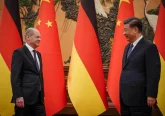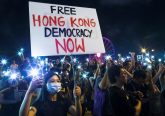It has become a recurrent point for commentators to propose that we are living in the remnants of an old and dying world order with a new one waiting to take over. Namely, they predict that the US and the West is on the verge of losing its global hegemony to Asia. Even before Covid-19, many predicted that a Chinese-led world order was imminent, as evidenced by a photo in 2018 of US-China trade discussions.

Philosopher Antonio Gramsci described such a period as an interregnum where “a great variety of morbid symptoms appear.” The divergent world responses to Covid-19 have been viewed as evidence of these symptoms. Commentators have continuously compared the inertness of Western governments with the efficiency of China, South Korea, Hong Kong, Singapore and Japan. China especially was heralded for its rapid and efficient response to the Covid-19 outbreak. This seemed to prove that ‘The Rest’ was now better than the West and signal the dawning a less Western-centric world order. In the mind’s of some, the dawn of a Chinese-led world order seemed inevitable.
However, in this piece, I argue predictions about Covid-19 foreshadowing the collapse of the US power in the world are misguided. China will not come to dominate the world as the US did after World War II. Instead, we could be witnessing a more nuanced change where the new world order is no longer homogeneous collective led by one country.
First, the US is unlikely to be dislodged from its global power due to the continued dominance of the Dollar and the US military. First, the US remains the most powerful actor in the monetary realm. This pandemic and the 2008 financial crisis both show that the US Dollar props up states in crisis. No currency has usurped it. And, the US Federal Reserve is perhaps the closest thing to a 999 call for states. Predictions that this power is waning are incorrect. In fact, during crises like in 2008, the dollarised economies’ cooperation grew closer, as they shut out others. Even if there is an antagonist in the White House, few Western allies are seriously considering uncoupling from the Dollar for international financial transactions. The US also remains the most prominent provider of military protection. None of its allies states have abandoned the US military in favour of Russia and China. Some allies—like Saudi Arabia and the UK—are particularly close to the US through the purchase, research and development of its weapons.
This monetary and military cooperation suggests that the current US-led liberal international order is not as global as its champions like to imagine; it is more of an order for rich countries tied financially and militarily to the United States. And, this view is steadily advancing in Washington. The continued strength of the Dollar and the US military as instruments of foreign policy will undoubtedly shape what kind of power the US is going to be in a more multipolar world. It will be static even as its power in promoting international liberalism, dominating global trade, and soft power steadily declines.
Further, predictions around the future of the world order rely on a faulty narrative. Inevitably, many discussions around the US and China try to predict who will rule the world. This assumes that China wants to rule the world and that the United States already does. It re-bottles Cold War thinking, rather than recognising that China has been a major global power for some time. And, it ignores that the EU through the ‘Brussels Effect’ and Russia exercise global power, too. There must be a distinction between ruling the world and having a global footprint. And, it is worth wondering if a country today can truly ‘rule the world’. Certainly, since 2008, economic activity has grown massively in the Asia-Pacific region and away from the Atlantic. But it would surely be a challenge for any country to have 40 percent of global GDP as the US did in 1960. This is what enabled it to rewrite the rules for global institutions like the UN and the World Bank.
On first impression, evidence of the West’s decline is in its lacklustre response to the Covid crisis compared to Asian states. This narrative ignores that across the world responses are patchy. Some countries in Asia were more successful than others in their response. It also passes over the lack of health and safety measures in Wuhan’s food market, the secrecy of the Chinese government that initially delayed confronting the crisis, and that the death toll could be higher than official estimates. Cross-country comparisons are inherently faulty as states do not count cases and deaths in the same way, and they have peaked at different times, too.
Speaking of the inevitability of Asian world dominance forgets that the region weathers its own crises: Japan’s ‘Lost Decade,’ the Asian Financial Crisis of 1997, recurrent Russian financial and energy crises, and 2015 Chinese stock market crash. Even before Covid-19’s outbreak, China faced both a looming age demographic crisis and a general economic slowdown. Mismanagement of crises is not unique to the East or West. It is inevitable, as states govern national economies whose existence is deeply connected to the global economy.
The crisis generated from Covid-19 does not signal the arrival of a new Chinese-led era in global governance. Rather, it suggests that the entire notion of a change in the ‘world order’ reproduces a bipolar analytical lens in an increasingly multipolar world. The US-led liberal international order is far less of a ‘world’ order, and more of a semi-exclusive club. Moving forward, the world will continue to march towards multipolarity.






